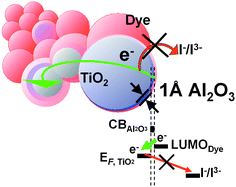Enhanced performance of dye-sensitized solar cells by an Al2O3 charge-recombination barrier formed by low-temperature atomic layer deposition†
Abstract
Al2O3 films are deposited conformally and uniformly by

* Corresponding authors
a
Department of Materials Science and Engineering, National Taiwan University, Taipei, Taiwan, Republic of China
E-mail:
ftsai@ntu.edu.tw
Fax: +886 2 33665388
Tel: +886 2 33665302
b Photovoltaics Technology Center, Industrial Technology Research Institute, Hsinchu, Taiwan, Republic of China
c Department of Materials Science and Engineering, National Chiao Tung University, Hsinchu, Taiwan, Republic of China
Al2O3 films are deposited conformally and uniformly by

 Please wait while we load your content...
Something went wrong. Try again?
Please wait while we load your content...
Something went wrong. Try again?
C. Lin, F. Tsai, M. Lee, C. Lee, T. Tien, L. Wang and S. Tsai, J. Mater. Chem., 2009, 19, 2999 DOI: 10.1039/B819337A
To request permission to reproduce material from this article, please go to the Copyright Clearance Center request page.
If you are an author contributing to an RSC publication, you do not need to request permission provided correct acknowledgement is given.
If you are the author of this article, you do not need to request permission to reproduce figures and diagrams provided correct acknowledgement is given. If you want to reproduce the whole article in a third-party publication (excluding your thesis/dissertation for which permission is not required) please go to the Copyright Clearance Center request page.
Read more about how to correctly acknowledge RSC content.
 Fetching data from CrossRef.
Fetching data from CrossRef.
This may take some time to load.
Loading related content
